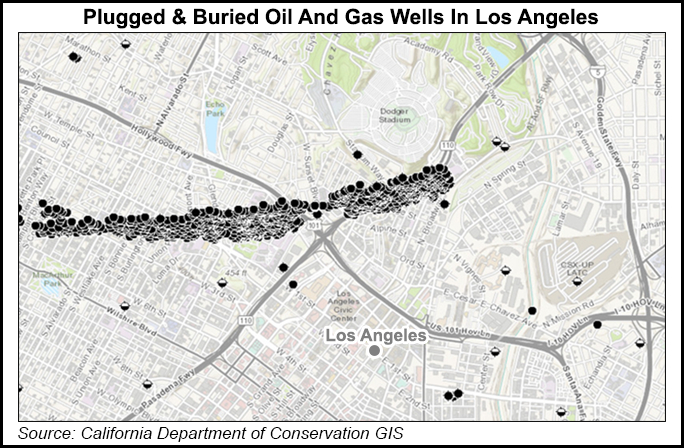Regulatory | NGI All News Access
California Renewing Effort to Seal Abandoned Oil/Gas Wells
California oil/natural gas regulators are targeting two old, poorly abandoned oil wells in a residential neighborhood near downtown Los Angeles in an effort to shine a light on “orphan” wells, of which there are hundreds, if not thousands, throughout the state.

Budget and logistical constraints limit the orphan wells that are identified and permanently sealed each year to ones that present the biggest environmental and safety risks to nearby populations, said a spokesperson at the state Department of Conservation’s (DOC) Division of Oil, Gas and Geothermal Resources (DOGGR), which has been permanently sealing orphan wells since 1977.
California’s orphan wells in many cases pre-date any state regulation of the industry, as was the case in the two wells identified Wednesday in Los Angeles that date back before 1903 in an old neighborhood called Echo Park, just a few miles northwest of downtown.
In the front yard of two homes on the same residential street, the wells’ last known operators were Manley Energy Co. and H. Rogalske, neither of which were located for legal action, although DOGGR issued remediation orders against them last year and in 2012. The two parties walked away from the wells in the very early 1900s, the DOGGR spokesperson said.
“The wells pose no imminent danger, but they are very old, near homes and will continue to deteriorate without intervention,” the DOGGR spokesperson said.
“The owners and operators never properly sealed the wells, so now the state must step in and close them correctly,” said David Bunn, director of the DOC.
Typically, the sealing of a well takes about six weeks, DOGGR said. Since the four-month-long gas storage well leak at Aliso Canyon, attention has been drawn to California’s multitudes of active and inactive oil/gas wells (see Shale Daily, March 10).
Los Angeles Mayor Eric Garcetti and the city’s manager of emergency management, Aram Sahakian, joined DOGGR to emphasize that local and state authorities are paying more attention to the oil/gas wells, which are pervasive, numbering 5,131 in the city alone, 825 active and the rest in various states of being plugged and abandoned. City statistics account for 266 idle wells visible at the surface, 56 of which are orphan wells. Of the city’s 891 known and buried wells, all but 21 are orphans.
Since 1977, DOGGR has plugged 1,350 orphan wells at a cost of more than $27 million, using funds collected from industry operators. Authorized to spend $1 million annually on the orphan wells, DOGGR is pushing for more and sponsoring state legislation (AB 2729 and AB 2756) to protect groundwater resources by improving the testing of idle wells and by boosting DOGGR’s enforcement powers, respectively.
© 2024 Natural Gas Intelligence. All rights reserved.
ISSN © 1532-1231 | ISSN © 2577-9877 |
